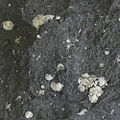A QAPF diagram is a doubled-triangle plot diagram used to classify igneous rocks based on their mineralogy. The acronym QAPF stands for "quartz, alkali...
7 KB (856 words) - 01:07, 28 April 2025
plagioclase. This places andesite in the basalt/andesite field of the QAPF diagram. Andesite is further distinguished from basalt by its silica content...
25 KB (2,764 words) - 14:51, 4 June 2025
present. This is reflected in the position of the trachyte fields in the QAPF diagram. Biotite, clinopyroxene and olivine are common accessory minerals. The...
19 KB (2,094 words) - 10:32, 8 June 2025
granitic rocks in the Sierra Nevada, United States. According to the QAPF diagram, granodiorite has a greater than 20% quartz by volume, and between 65%...
8 KB (882 words) - 18:13, 7 June 2025
rocks, and most plutonic rocks are classified by where they fall in the QAPF diagram. Dioritic and gabbroic rocks are further distinguished by whether the...
10 KB (1,171 words) - 01:32, 22 November 2024
feldspar, or feldspathoid minerals, classification begins with the QAPF diagram. The relative abundances of quartz (Q), alkali feldspar (A), plagioclase...
19 KB (2,320 words) - 17:26, 18 October 2024
feldspar, or feldspathoid minerals, classification begins with the QAPF diagram. The relative abundances of quartz (Q), alkali feldspar (A), plagioclase...
23 KB (2,458 words) - 11:51, 12 August 2024
which can be mistaken for rhyolites. For phaneritic felsic rocks, the QAPF diagram should be used, and a name given according to the granite nomenclature...
6 KB (655 words) - 07:18, 23 November 2024
in dacite, and in many other volcanic rocks, are illustrated in the QAPF diagram. This defines dacite as having a content of 20% to 60% quartz, with plagioclase...
17 KB (1,875 words) - 15:09, 4 June 2025
present. This places basanite in the basanite/tephrite field of the QAPF diagram. Basanite is further distinguished from tephrite by having a normative...
8 KB (768 words) - 22:42, 18 August 2024
minerals present. These percentages place the rock somewhere on the QAPF diagram, which often immediately determines the rock type. In a few cases, such...
48 KB (5,656 words) - 22:48, 24 May 2025
Monzogranite is a plutonic rock that occupies the middle of the QAPF diagram, consisting of between 20–60% quartz, and of the remainder, between 35–65%...
6 KB (602 words) - 18:11, 26 May 2025
usually alkali feldspar. Granitic rocks are classified according to the QAPF diagram for coarse grained plutonic rocks and are named according to the percentage...
60 KB (6,876 words) - 13:10, 23 May 2025
hue; peppered with minor amounts of black minerals. As shown in the QAPF diagram, alkali feldspar granite contains between 20% - 60% quartz. Less quartz...
4 KB (353 words) - 04:41, 3 June 2025
from the otherwise similar basanite. It's parameters are defined in the QAPF diagram. Occurrences include leucite nepheline tephrite from Hamberg bei Neckarelz...
1 KB (115 words) - 22:41, 18 August 2024
part of the diagram. Ternary diagram, just one triangle QAPF diagram, a common application Wikimedia Commons has media related to Piper diagram. Piper, Arthur...
6 KB (553 words) - 02:53, 23 March 2024
feldspar content. This places basalt in the basalt/andesite field of the QAPF diagram. Basalt is further distinguished from andesite by its silica content...
70 KB (7,838 words) - 14:53, 20 May 2025
feldspar, and feldspathoid (the QAPF classification). Monzonite is defined as rock having less than 5% quartz in its QAPF fraction and in which alkali feldspar...
8 KB (898 words) - 02:21, 2 June 2025
volume of its total content of quartz, alkali feldspar, and plagioclase (QAPF) and alkali feldspar makes up 35% to 90% of its total feldspar content. Feldspathoids...
21 KB (2,239 words) - 05:23, 19 February 2025
more than 20% of the total quartz-alkali feldspar-plagioclase-feldspathoid (QAPF) content of the rock. Amphiboles and biotite are common in lesser quantities...
4 KB (440 words) - 23:06, 30 December 2024
TAS classification (redirect from TAS diagram)
as the QAPF diagram, or one of the other diagrams available for igneous rocks may be suitable. Before classifying rocks using the TAS diagram, the chemical...
4 KB (600 words) - 02:56, 15 November 2023
Under IUGS guidelines, rhyodacites are not formally defined in either the QAPF classification, used to classify igneous rocks by their mineral content,...
5 KB (461 words) - 05:16, 26 May 2025
QAPF diagram that shows the quartz (Q), alkali feldspar (A), and plagioclase (P) composition of syenite...
11 KB (1,199 words) - 16:05, 27 April 2025
plagioclase. Alkali feldspar appears as the silica content becomes high. Under the QAPF classification, plagioclase is one of the three key minerals, along with...
25 KB (2,886 words) - 00:19, 3 January 2025
tephritic foidites. Some foidolites are a potential source of aluminium. QAPF diagram Le Maitre, R.W., ed. (2002). Igneous Rocks — A Classification and Glossary...
1 KB (104 words) - 18:19, 23 January 2024
mafic lavas are less explosively violent than felsic-lava eruptions. QAPF diagram List of minerals List of rock types Bowen's reaction series Cross, Whitman;...
7 KB (736 words) - 17:29, 10 September 2024
rhomb porphyry places it in the trachyte - latite classification of the QAPF diagram. Latite is found, for example, as lavas in Bulgaria and as intrusive...
3 KB (235 words) - 19:29, 8 July 2024
This places hawaiite in the S1 field of the TAS diagram. Hawaiite is not a recognized rock type in the QAPF classification of igneous rock, which is based...
6 KB (724 words) - 05:16, 19 February 2025
identifies rocks according to mineralogical criteria. Utilising the IUGS QAPF diagram of Streckeisen (1974) "essexite" is more formally known as nepheline...
4 KB (361 words) - 14:16, 8 December 2023
Commission on Petrology in 1970. The QAPF diagram for the classification of igneous rocks is also known as "Streckeisen diagram" in his honour. He began his work...
4 KB (291 words) - 08:49, 7 March 2024

























